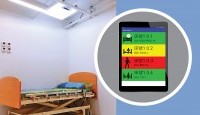
Technology & InnovationTechnology
AI-powered WiseEye automates fabric fault detection
An intelligent automatic system for detecting fabric defects and improving quality control process has shown remarkable success in initial industry testing.
One of the biggest challenges in the textile industry is detecting defects in materials to ensure high-quality products. Traditionally, fault detection has relied on the naked eye, but this tends to be inconsistent and inefficient at the task. Although some automated systems have been developed, they are expensive, have limited functionality and have a high rate of false alarms.
WiseEye is an intelligent fabric fault detection system developed by the Textile and Apparel Artificial Intelligence Research Team, headed by Prof. Calvin Wong of the Institute of Textiles and Clothing. Integrating advanced technologies including AI and deep learning, this system comprises various components that perform different functions: A high-powered LED light bar illuminates the fabric and a high-resolution charge-coupled device camera is mounted on a rail to capture images of the whole width of the fabric during the weaving process. The images are then fed into an AI-based machine vision algorithm to detect fabric defects. The computer system receives real-time information, whereas analytical statistics and alert can be generated as necessary.
Prof. Wong explained that “WiseEye is not only a technological breakthrough that meets industry needs, but it also marks a significant milestone in the quality control automation for the traditional textile industry”.
Big data and deep learning technologies were also used in WiseEye. With input of data on thousands of yards of fabric into the system, WiseEye was trained to detect some 40 common fabric defects with exceptionally high accuracy at a resolution of up to 0.1 mm/pixel.

Common fabric defects detected
by the WiseEye system.
The WiseEye system was tested in a manufacturing environment for more than six months. It was able to reduce loss and wastage due to faulty textiles by 90%, thus allowing considerable savings and enhancing production efficiency.
Currently, the system can be applied to most types of fabric with different weaving structures in solid colours. The research team plans to further develop WiseEye to detect defects in fabrics with complicated patterns, such as stripes and checked patterns, with a view to improving the quality of textiles and clothing for consumers.










